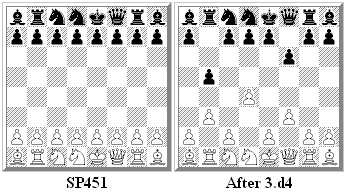Comparing the first diagram (SP451, BRNNKQRB) with the second, an inexperienced chess960 player might get the impression that the players have been moving their Pawns at random. There is, in fact, an instructive chunk of logic behind the moves leading to the second diagram.

One of the main features of this start position is that the four Bishops all start in the corners. Another feature is that all Bishops are protected by their respective Rooks.
The Bishops in the corners usually dictate a positional duel at the beginning of a game, since both players are forced to develop their Bishops on the long diagonals, where they come into contact immediately. The player who is the first to open a long diagonal can exchange Bishops as soon as the opponent opens the same diagonal. Balancing this, the decision to open either diagonal first leaves the opponent the opportunity to open the other diagonal first.
In the current game, White chose to open the a1-h8 diagonal with 1.b3. If Black plays 1...g6, White can exchange Bishops and Black will no longer be able to castle O-O. Black followed a similar strategy on the a8-h1 diagonal with 1...b5, but grabbed more space than White and left the possibility of ...Nc8-b6.
Now White continued the duel on the diagonals by playing 2.f3. This prepares a subsequent g2-g3 without allowing the exchange of Bishops on h1, thereby preserving the option to castle O-O. Black followed an identical strategy with 2...f6.
Now White made an overt play for space in the center with 3.d4, preparing Nc1-d3 and leading to the second diagram. He might not have noticed that his third move closed the a1-h8 diagonal, giving Black the chance to play the surprising 3...f5, advancing the f-Pawn for the second consecutive move. Consequently, Black's dark squared Bishop will have more freedom on its long diagonal than White's light squared Bishop will have.
After three moves each, the contours of the subsequent struggle have been defined and the game is launched. The PGN for the full game, courtesy Chesstigers.de, is:
[Event "CCM9 - Chess960 Rapid WCh"]
[Site "Mainz"]
[Date "2009.07.30"]
[Round "8.1"]
[White "Aronian, Levon"]
[Black "Nakamura, Hikaru"]
[Result "0-1"]
[WhiteElo "2800"]
[BlackElo "2777"]
[Variant "chess 960"]
[SetUp "1"]
[FEN "brnnkqrb/pppppppp/8/8/8/8/PPPPPPPP/BRNNKQRB w GBgb - 0 1"]
[Source "Chess Tigers"]
1.b3 b5 2.f3 f6 3.d4 f5 4.Nd3 g6 5.Qf2 Bf6 6.g3 Qh6 7.e3 Ne6 8.Qe2 Nb6 9.Nc3 a6 10.Nc5 Nxc5 11.dxc5 Qg7 12.Qd3 b4 13.cxb6 cxb6 14.Nd5 Bxa1 15. Nc7+ Kf7 16.O-O Bc3 17.f4 Bxh1 18.Kxh1 Qf6 19.Rbd1 Qc6+ 20.Qd5+ Qxd5+ 21. Rxd5 Rb7 22.Nxa6 Ra8 23.Nxb4 Bxb4 24.a4 Bc5 25.Re1 e6 26.Rd3 d5 0-1
Nakamura appears to have outplayed Aronian already in the opening.

No comments:
Post a Comment